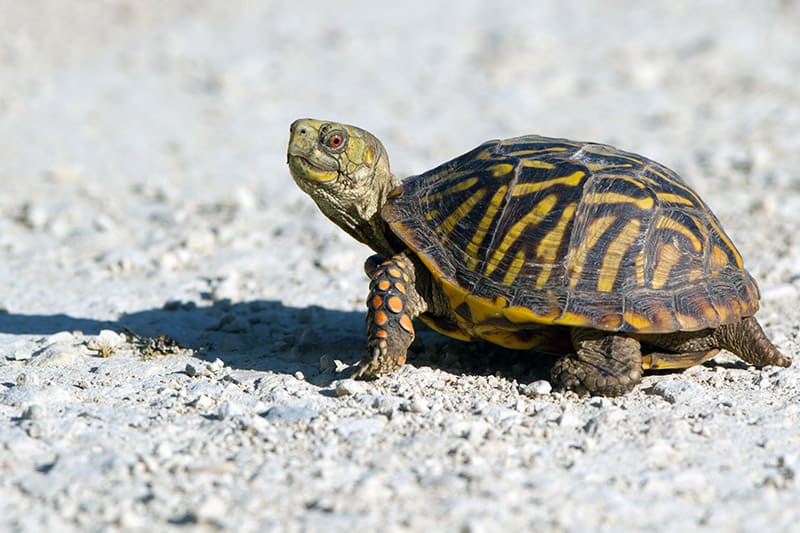The western box turtle or Ornate Box Turtle is perhaps one of the most commonly available of all the box turtles!
There are two species of box turtles found in the united states, the eastern box turtle species T. carolina, and the western box turtle species T. ornata. The western box turtles are comprised of two subspecies, this turtle the Ornate Box Turtle T. o. ornata and its more arid dwelling counter part the Desert Box Turtle T. o. luteola. Both of the western box turtles are more difficult to acclimate than their eastern relatives.
The Ornate Box Turtle is quite colorful. At first glance it looks similar to the Florida Box Turtle due to the color patterning of its shell. However the carapace of the Ornate Box Turtle, though domed, is flattened on top and the radiating yellow lines are often thicker and not as cleanly defined. It also has spots on the sides of its head rather than the two distinct yellow lines of the Florida Box Turtle.
These wonderful animals are fairly small, quiet, and don’t bite. They may seem like a desirable pet, however there are a few things to keep in mind before acquiring one. Both of the shy western box turtles are more difficult to acclimate and establish in captivity than any of their eastern cousins. They are sensitive to their captive environment and can take time to become comfortable. All box turtles are solitary creatures and do not need companions. They need to be protected from other household pets, such as a dog. And lastly, they are fun to watch but they do not enjoy being handled.
- For more Information see: Guide to a Happy, Healthy Box Turtle
Distribution
The Ornate Box Turtle Terrapene ornata ornata was described by Agassiz in 1857. They are found from Indiana and South Dakota to the lower Rio Grande valley, inhabiting plains and prairies in areas of scrub and low brush thickets.
There are two subspecies of western box turtles in the genus Terrapene ornata. The other is the Desert Box Turtle T. o. luteola found in New Mexico and western Texas south into Mexico. These turtles have a lighter background color and lighter radiating lines on the carapace than the Ornate. Older species often fade into a more solid tan or horn color. Although they are still common in many areas, the number of western box turtles has drastically declined.
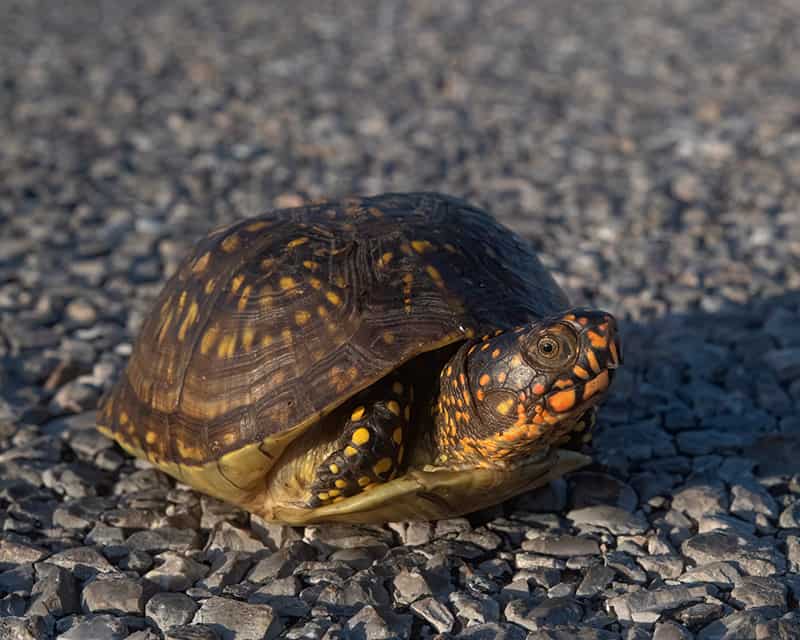
Status
This turtle is listed on the IUCN Red List of Threatened Species: LR – lower risk, and listed on CITES: Appendix II, as well as being listed on Wisconsin’s Endangered and Threatened Species List in l972.
Description
Box turtles have a highly domed carapace (upper shell) and a hinged plastron (bottom shell) that can be completely shut to keep out predators. These characteristics contribute to this turtle’s descriptive name, ‘box turtle’.
The Ornate Box Turtle is more brightly colored than Desert Box Turtle, and somewhat similar in appearance to the Florida Box Turtle.The brown carapace of the Ornate is domed but flattened on top, and the radiating yellow lines are often thicker and not as cleanly defined as its Florida cousin. Its skin is dark gray with yellowish or white spots rather than lines on the side of the head.
Males eyes are usually bright red or orange and they have a slightly concave plastron (bottom shell). Males also have a somewhat thicker and longer tail than females, and the innermost toes on their hind feet are enlarged and angled differently than the other toes. Sometimes a mature male will have a greenish head. The females eyes are usually dark red or brown and their plastron is flat.
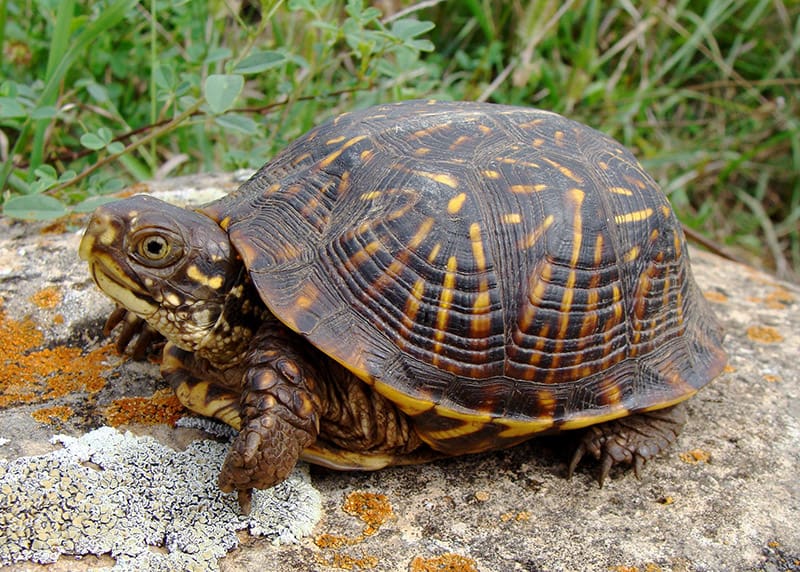
Care and Feeding
Western box turtles are omnivores and feed on a huge variety of food in the wild. In captivity, they are especially fond of live food such as earthworms, superworms, redworms, wax worms, crickets, pink mice, and even goldfish.
In addition to this large variety of live foods, you can offer chopped fruits and vegetables. Finely grated dark green veggies such as lettuces and kale, and fruits such as melons, berries, cantaloupe, are also accepted (though not eagerly) once or twice a week.
They will eat MAZURI® Tortoise Diet and high-quality canned cat food (beef, chicken, turkey, etc.), but this should only be a small part of their overall diet. Many keepers choose not to feed cat food as it is high in fat and protein which can lead to obesity and shell deformities.
These turtles must always have access to clean water. A plastic paint tray, large plant saucer, or shallow cat litter pan is placed inside to create a water area. (The plastic paint tray is sloped and so provides a grade that even the smaller turtles can use to get out of the water.) The water in the tray or tub will need to be changed often as the box turtles will soak and defecate in it regularly.
Environment
Indoors
Indoors, these more arid-dwelling western box turtles can be set up in large tubs (48″ w x 84″ l x 24″ deep). Substrate consists of a mixture of ¾ dampened river or play sand and ¼ peat moss, but first add about 10″ of pea gravel to the bottom to pea gravel to the bottom to allow drainage during spring “rains”. A cat litter pan, paint tray, or plant saucer placed inside creates a water area. Add a shelter in the form of a large piece of slate resting solidly on a stack of bricks. Spray water under this shelter once a week to keep this area humid.
A shop light fixture with UVB-emitting bulbs is set up overhead. Add heat via a clamp lamp fixture with a 100-watt T-Rex Active UVHeat® bulb. Maintain the hot spot below this lamp at 90{deg} to 95{deg} F (32{deg} to 35{deg} C) throughout the spring and summer months. These box turtles will hibernate at a moderate temperature 50{deg} F (10{deg} C) for 30-45 days.
Outdoors
These active and personable turtles do very well in outdoor enclosures. An ideal setup that will work year round involves providing an enclosed (fenced-in type) habitat. Stacking two rows of railroad ties or landscape timbers can form the outside barrier. For these arid box turtles, sink a 10″ strip of metal flashing at the base of each railroad tie because they are active diggers. Place the habitat in a more sunny location, add lots of slate and some plants, and start one or two shallow burrows for the turtles to enlarge into a more permanent residence. There also needs to be a small patch of soft ground, prepared by digging the soil up and adding some sand, peat moss, and leaf compost.
Even these desert-dwelling species have a microhabitat such as abandoned animal burrows, large piles of fallen cacti, etc. that is quite humid. Plants such as succulents and cacti can be added. Spineless Opuntia cacti make especially good additions for cover and to provide some extra browse. As these plants survive fairly well during cold months, they can provide good cover and some food throughout the year. These burrows will provide the necessary humid shelters for these turtles.
- For more details on providing an outdoor enclosure for your box turtle, see: Guide to a Happy, Healthy Box Turtle: Outdoor housing.
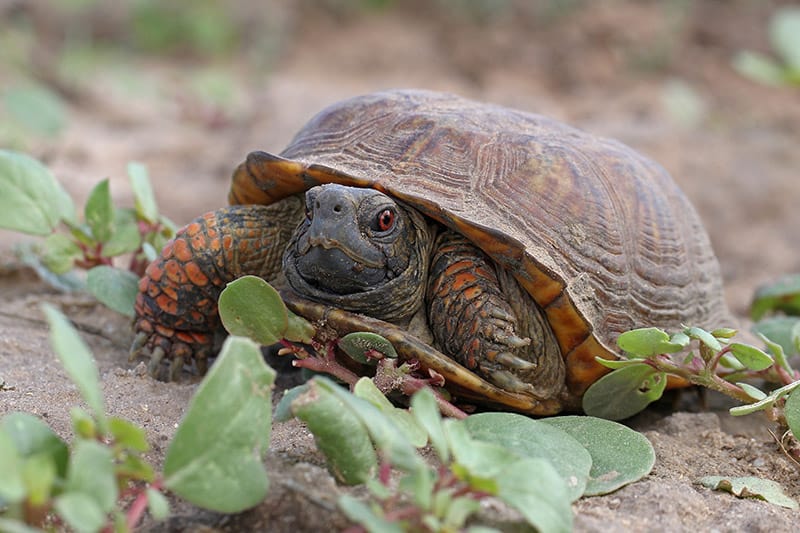
Handling
As with all turtles, we suggest that keepers keep handling to a minimum. They can be handled when their enclosures are cleaned or when they are moved from indoor enclosures to outdoor enclosures, but they are definitely not hands-on pets. We do suggest, however, that you give them a once-a-month to check for any signs of health-related problems.
Breeding
Once established in a secure and healthy environment, wastern box turtles are typically very good breeders. They can be prolific and can produce multiple clutches of viable eggs each breeding season.
Hibernation is the trigger for mating in most species of box turtles. Most temperate species (T. carolina subspecies, some T. ornata) will require a period of hibernation in the 50{deg} to 60{deg} F (10{deg} to 16{deg}C) range. Most box turtle breeders cool the adults of these species for as few as 30 days to as much as 90 days during the cooler months. Rain, both natural and man-made, is an important trigger for courtship and breeding.
Females can lay up to three clutches of from two to eight. The eggs typically incubate for 75 to 85 days at 75% to 85% humidity. Box turtles exhibit TSD (Temperature-dependent Sexual Determination). Eggs incubated at 71{deg} F (22{deg} C) produce males. Eggs incubated at 79{deg} F (26{deg} C) produce a mixed ratio of males and females and eggs incubated at 88{deg} F (31{deg} C) produce females.
- For more information on breeding, hibernating, and caring for the young, see: Guide to a Happy, Healthy Box Turtle: Breeding – Hibernating and Hatchling Care
Interestingly, female box turtles have been known to store sperm and produce viable eggs for up to four years after copulation (Ewing, 1943 and de Vosjoli & Klingenberg, 1995).
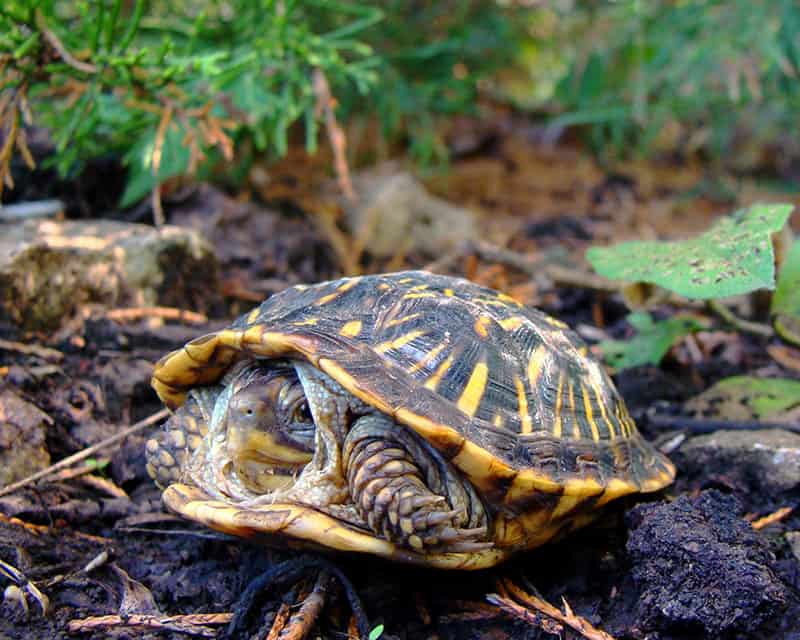
Ailments / Health Problems
Like many reptiles, wastern box turtles can be susceptible to illness, disease, and injury. However many ailments are preventable simply from taking proper care of the animal. Be sure to provide your pet with the right type of environment for its needs, keep it’s enclosure clean and maintained, and provide it with a proper diet.
Some ailments that can affect box turtles are respiratory infections, eye-related problems, larvae of parasitic flies, injury, stress, and shell damage.
- For more information on ailments and what to do about them see: Guide to a Happy, Healthy Box Turtle: Ailments – Health Issues
Availability
Ornate Box Turtles are occasionally available through pet stores, being more readily available at reptile shows, and on-line.
Though young box turtles are somewhat delicate and sensitive to husbandry errors, it is very important for hobbyists to purchase captive-produced animals whenever possible. Typically, the many wild-caught box turtles that are available each year do poorly in captivity due to stress, dehydration, and internal parasite issues.
All box turtles are becoming more commonly available as captive-hatched specimens. Support turtle breeders by purchasing their healthy, captive bred offspring. Some breeders take their offspring to local shows as it is easier (and much better for the delicate hatchlings) to sell them to someone without having to ship them across the country. This is better for the small turtle and better for the keeper.
Watch on-line classifieds for a breeder in your area or attend one of the larger reptiles shows in the country to find captive-hatched box turtles.
Featured Image Credit: Martha Marks, Shutterstock
